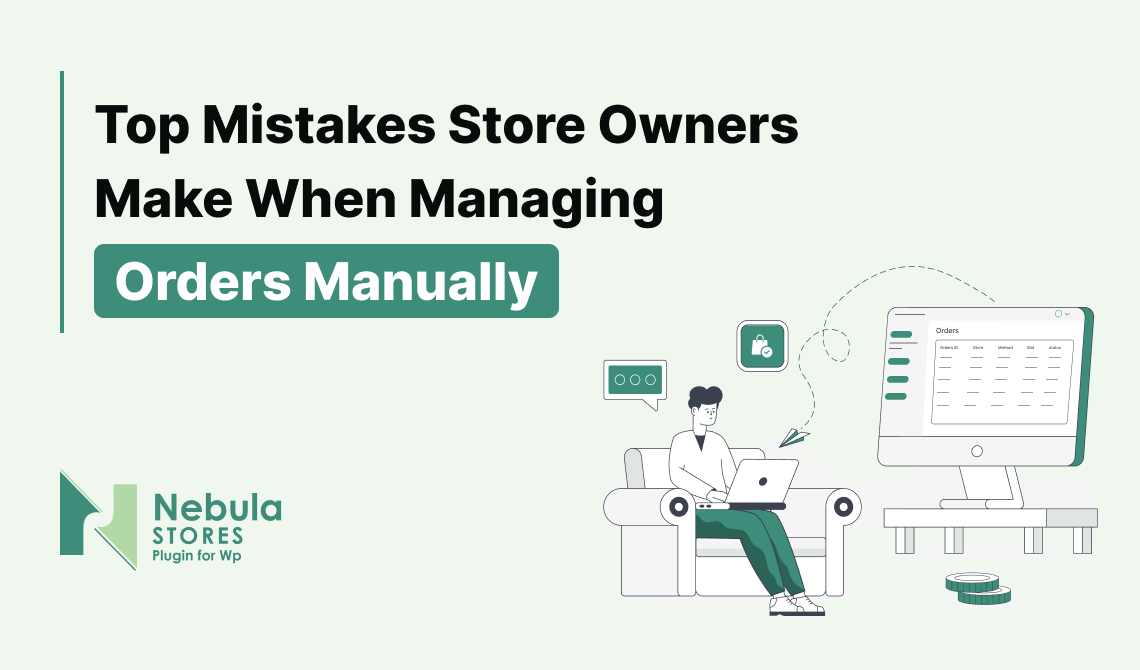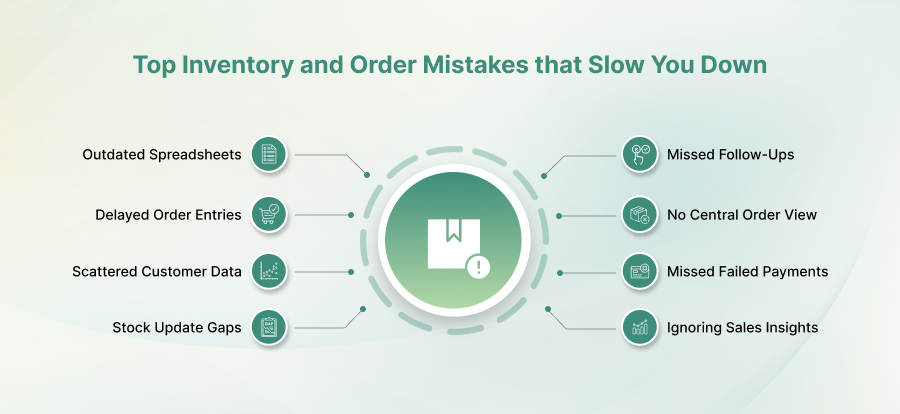
Let me tell you straight away…
Handling manual orders in your WooCommerce store might seem manageable at first, but it can quickly turn into a juggling act. Let me tell you straight away… your store gets orders day and night, yet instead of moving seamlessly, each one means updating spreadsheets, digging through inboxes, and checking stock by hand.
It works.. until it doesn’t.
One wrong copy-paste, one missed email, and a customer is chasing you for an update. Multiply that by dozens of orders, and the cracks start showing – delays, errors, and a team that’s always catching up.
Manual order management isn’t just slow. It’s like racing a sports car in first gear. In eCommerce, that means losing sales and customers fast.
And in today’s fast-moving eCommerce world, those risks add up to lost revenue and unhappy customers.
We’ll look at the most common mistakes store owners make when managing orders manually, and how pairing WooCommerce with Zoho CRM through the Nebula Store Plugin can replace the chaos with a reliable, automated process.

Spreadsheets can be handy when you’re starting out. But as manual orders stack up, they turn into a liability. One copy lives on your laptop, another on your teammate’s desktop, and neither one is fully up to date.
By the time you realise something’s wrong, the wrong product could already be on its way to the wrong customer. That’s refunds, re-shipping, and unhappy buyers you now have to win back.
With manual order management, new orders often sit in limbo until someone has time to enter them. That gap slows down packing, delays shipping, and leaves customers waiting longer than they should.
It’s the eCommerce version of keeping someone standing at the counter because you can’t find a pen. Competitors who move faster will happily take those customers next time.
Bits of customer info end up everywhere – a few details in an email, a note scribbled on paper, a conversation in chat. Without everything in one place, you lose the ability to see the full story. That means no personal touches, no quick problem-solving, and no sense of loyalty from the customer. And when loyal customers leave, replacing them is expensive.
If your inventory gets updated only when someone remembers, mistakes are inevitable. One missed update can mean selling an item you no longer have or showing something as “out of stock” when it’s sitting right there in your warehouse. This is a common problem when dealing with manual orders at scale.
When you’re buried in daily tasks, follow-ups can feel optional. They’re not. No thank-you message, no review request, no “how did we do?” and the customer assumes the relationship ended as soon as the payment cleared. That’s a missed chance for repeat sales and free word-of-mouth promotion.
If sales, support, and fulfillment are all working from different systems, nobody sees the full picture. Support might promise express shipping without knowing the warehouse is already backed up. Sales might push a bulk order without checking if you have the stock. Miscommunication like this is a major side effect of manual orders.
A failed payment in a manual process can slip past unnoticed. You think the order’s good to go, but the payment never lands in your account. By the time you catch it, the customer may have lost interest, or worse, you’ve already shipped the goods without getting paid.
Manual management keeps you in constant “react” mode. You process manual orders, pack them, ship them, and move to the next. But you’re not stopping to see which products are selling fastest, who your best customers are, or when you’ll run out of stock. That lack of insight turns growth into guesswork and leaves you exposed when sales slow or demand shifts suddenly.
In fact, over 60% of businesses struggle with inefficient manual order management, leading to avoidable losses.
As Jeff Bezos once said, “If you do build a great experience, customers tell each other about that. Word of mouth is very powerful.”
Here’s what recent research says about how manual order management impacts performance:
| Issue | Percentage Impact | Source |
| Businesses struggling with process inefficiencies | Over 50% | McKinsey research on inefficiencies in workflows |
| Manual order processing increases operational costs | 30% more costly | McKinsey estimate on manual vs automated order processing conexiom.com |
| Customer abandonment after multiple late deliveries | 65% | Voxware survey, via ProcurementTactics Procurement Tactics |
| Loyal customers are more likely to repeat purchases | 70% more likely | Adobe statistic via VWO insights Website |
| High-performing supply chains use AI/ML for order management | 33% | Gartner data via SupplyChainBrain Supply Chain Brain |
As we’ve just talked about, those silent mistakes in manual order management can quietly drain time, money, and customer trust. Now, let’s look at how to fix them.
Orders drop straight into Zoho CRM instantly
A customer places an order late Saturday night. By Sunday morning, it’s already in Zoho CRM with all details ready for your team to act on, no weekend data entry, no delays.
Customer details update automatically
A returning customer calls about a repeat purchase. You open their profile in Zoho CRM and instantly see what they ordered last time, when it was shipped, and any past issues – so you can serve them without digging through old records.
All order, customer, and stock data in one place
Instead of flipping between spreadsheets, inboxes, and warehouse lists, you log into Zoho CRM and everything is there. Your sales rep can promise delivery knowing fulfillment already sees the order.
Emails go out automatically
The moment an order ships, the customer gets their tracking email – without anyone having to remember to send it. No more “Where’s my order?” emails clogging your inbox.
Stock updates in real time
Sell the last unit of a product at 2:15 p.m., and your WooCommerce store updates instantly. No overselling, no awkward refund emails.
Reports that guide smart decisions
You can open Zoho CRM and instantly see your top-selling products, your biggest repeat customers, and which items are running low. Planning your next promotion becomes a numbers-backed decision instead of a guess.
| Manual Processes | Automation |
| Orders are entered when someone gets to it – delays are common. | Orders are synced instantly with no extra steps. |
| Details can be missed or mistyped during data entry. | Data moves automatically, with no risk of typos or omissions. |
| Customer experience changes depending on who’s handling the order. | Every customer gets the same fast, consistent service. |
| Workload grows quickly as sales increase. | Handle more orders without adding to your workload. |
| The team spends hours on repetitive admin tasks. | The team focuses on customers, growth, and problem-solving. |
Automation isn’t about removing people – it’s about removing the slow, error-prone steps that hold your business back.
The Nebula Store Plugin with Zoho CRM gives you a system that runs smoothly in the background so you can put your energy into the parts of your store that really matter.
What You’ll Get with Ecommerce Order Management Automation
If you want more profit, faster growth, and happier customers, stop letting manual order management hold you back. Every missed update, wrong shipment, or delayed follow-up is money out of your pocket.
The Nebula Store Plugin with Zoho CRM puts your WooCommerce store on autopilot – orders, stock, and customer communication handled instantly and accurately. You get more time to focus on sales, not spreadsheets.
You’ve seen the risks. You know the solution. The only thing left is to act.
